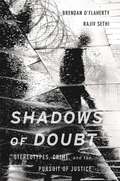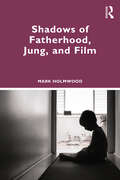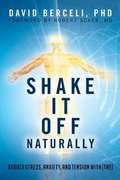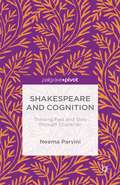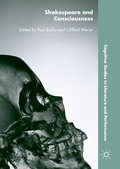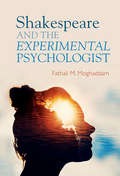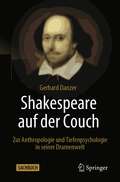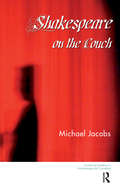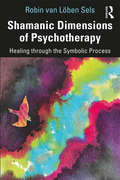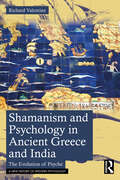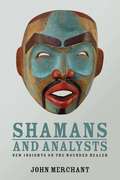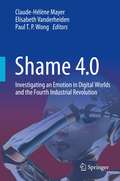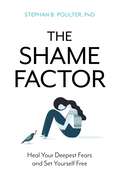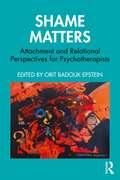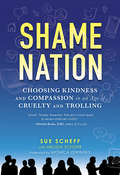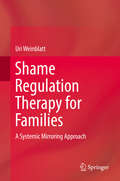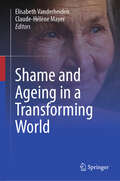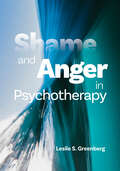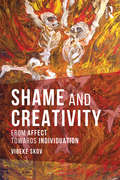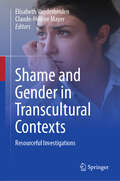- Table View
- List View
Shadows into Light: A Generation of Former Child Soldiers Comes of Age
by Theresa S. BetancourtA twenty-plus-year study of former child soldiers offers far-reaching insight into mental health and resilience after extreme trauma.During the civil war that ravaged Sierra Leone from 1991 to 2002, an estimated 20,000 children were forced to join the fighting. As villages were raided and youths rounded up, it was not uncommon for a child to be ordered to kill a friend, relative, or neighbor under threat of being killed themselves. The goal was to make it impossible for the captives to return home and be accepted back into their communities.But when the conflict ended, many of the children did find their way home. Could they reintegrate after such extreme trauma? Theresa Betancourt and her collaborators in Sierra Leone launched a study of more than 500 boys and girls who had been pulled into the war, tracking them for over two decades. The results were surprising: despite everything they had suffered, this was not a lost generation. In fact, the most dominant trend over time was one of healing and increasing acceptance. The lives of the former child soldiers were shaped not just by their personal ordeals but also, crucially, by the responses of their families, peers, and broader communities. Filled with vivid personal stories, Shadows into Light describes heartbreak and despair but also remarkable triumphs made possible by layers of social support and encouragement.Betancourt’s study provides unparalleled insight into the long-term psychological and developmental effects of family separation, war, and exposure to violence. The lessons go far beyond Sierra Leone’s tragedy, suggesting that we should, in general, think of children’s risk and resilience more as products of the post-trauma environment than as individual traits.
Shadows of Doubt: Stereotypes, Crime, and the Pursuit of Justice
by Brendan O'Flaherty Rajiv SethiCrime and punishment occur under extreme uncertainty. Offenders, victims, police, judges, and jurors make high-stakes decisions with limited information under severe time pressure. With compelling stories and data on how people act and react, O’Flaherty and Sethi reveal the extent to which we rely on stereotypes as shortcuts in our decision making.
Shadows of Fatherhood, Jung, and Film
by Mark HolmwoodEvery picture tells a story, and stories have the power to educate. Looking at two key Jungian archetypes – the father and the shadow – from a challenging perspective, this book investigates the negative, shadowy side of fatherhood and its detrimental effect on children by presenting a collection of stories from all over the world.Blurring the line between fiction and fact, art and academic theory, the book travels across a difficult psychosocial landscape, discussing family life, mental health, and criminality. Mark Holmwood highlights the educational value of these stories whilst exploring the father–child dynamic, adverse childhood experiences, father hunger, asymmetrical power relations, psychological manipulation, narcissism, domestic violence, sexual abuse, patricide, and filicide. Jungian and post-Jungian viewpoints on the bond between fathers and their children are woven into a bigger, interconnected narrative which invites the readers to re-think clinical, sociological, and mythological connections through the lens of modern masculinity and men’s studies. Discussing five different types of negative fathers, the book presents their children’s struggles and underlines their resilience at the same time, emphasising assertion, challenge, questioning, and if necessary, acceptance, all being a part of the complex and transformative psychological process called individuation.Written with a clear and direct style, Shadows of Fatherhood, Jung, and Film will be of interest to mental health professionals, Jungian scholars, students, teachers and researchers in social sciences, humanities, and the arts, as well as general readers with a distinctive interest in men’s studies, father–child relations, and cinema.
Shake it off Naturally: Reduce Stress, Anxiety, and Tension with (TRE)
by David Berceli<p>This book contains an easy to follow stress reduction exercise technique whose central aspect is the activation of a mild shaking response of the nervous system. It explores this most fundamental human experience of ‘shaking’ during highly excited experiences or events. This book explains how this natural shaking response is potentially capable of both relaxing physical tension patterns in the body as well as reducing psycho-emotional stress and tension. The technique explained in this book has demonstrated itself to be useful for people who are experiencing simple daily stress, long-term chronic tension, or even recovering from traumatic events. <p>This shaking response, which has been traced back through traditional cultures to present day medical science, is the body’s own natural neuro-physiological reaction to reduce stress. The combined writings of 24 authors representing 12 countries and 3 languages take the reader through the theoretical understanding of this shaking mechanism from neurological and physiological perspectives to its application with self, family, community and organizations as well as, active duty and veteran military personnel, first responders, refugee populations, and natural disaster survivors. The easy to follow pictures and explanations of these exercises guides the reader comfortably through this self-help, stress reduction process.</p>
Shakespeare and Cognition: Thinking Fast and Slow through Character
by N. ParviniShakespeare and Cognition challenges orthodox approaches to Shakespeare by using recent psychological findings about human decision-making to analyse the unique characters that populate his plays. It aims to find a way to reconnect readers and watchers of Shakespeare's plays to the fundamental questions that first animated them. Why does Othello succumb so easily to Iago's manipulations? Why does Anne allow herself to be wooed by Richard III, the man who killed her husband and father? Why does Macbeth go from being a seemingly reasonable man to a cold-blooded killer? Why does Hamlet take so long to kill Claudius? This book aims to answer these questions from a fresh perspective.
Shakespeare and Consciousness (Cognitive Studies in Literature and Performance)
by Paul Budra and Clifford WerierThis book examines how early modern and recently emerging theories of consciousness and cognitive science help us to re-imagine our engagements with Shakespeare in text and performance. Papers investigate the connections between states of mind, emotion, and sensation that constitute consciousness and the conditions of reception in our past and present encounters with Shakespeare’s works. Acknowledging previous work on inwardness, self, self-consciousness, embodied self, emotions, character, and the mind-body problem, contributors consider consciousness from multiple new perspectives—as a phenomenological process, a materially determined product, a neurologically mediated reaction, or an internally synthesized identity—approaching Shakespeare’s plays and associated cultural practices in surprising and innovative ways.
Shakespeare and the Experimental Psychologist
by Fathali M. MoghaddamGain a better understanding of human behavior by exploring thought experiments in Shakespearean plays and the historical roots of experimental psychology within early modern literature. This book combines scientific psychology with English literature to discuss thought experiments in selected Shakespeare plays and examine the central role of thought experiments in the natural sciences. Thought experiments are essential for progress in scientific research. Indeed, Albert Einstein and a number of other leading scientists relied almost exclusively on thought experiments. Thought experiments also play a pivotal role in English literature, particularly in Shakespeare plays. By focussing on thought experiments and experimental psychology's place within early modern English literature, the volume establishes a more wholistic approach to understanding human behavior.
Shakespeare auf der Couch: Zur Anthropologie und Tiefenpsychologie in seiner Dramenwelt
by Gerhard DanzerShakespeare ist als Autor weltberühmt. Er war allerdings nicht nur ein genialer Theater-Mann, sondern mindestens ein ebenso exzellenter Psychologe und Anthropologe, der das menschliche Dasein in allen seinen Schattierungen intuitiv verstanden, sowie mit künstlerischer Verve und literarischer Generosität auf die Bühne gebracht hat. Dieses Buch führt durch eine Auswahl seiner Stücke, fasst Handlungen zusammen, kommentiert Verhaltensweisen und interpretiert diese feinsinnig. Shakespeare wird hier als Psychologe und Anthropologe vorgestellt - höchst vergnüglich, hellsichtig und tiefgründig.
Shakespeare on the Couch (The\united Kingdom Council For Psychotherapy Ser.)
by Michael JacobsDrawing upon a vast literature in psychoanalytic journals and either upon Shakespeare's characters themselves or alluding to those characters in the course of other topics, this book discusses eight of Shakespeare's plays and the relationships between the main characters in them. Psychoanalytic and literary approaches sometimes diverge, but they can also concur in seeing characters either as true examples of different psychological states and types of relating or as symbolic of aspects of the personality. The chapters contain many references to psychoanalytic interpretations from Freud onwards, although these cannot be proved, and in some cases are over-stretched, there will be times when psychoanalytic criticism 'rings bells' in the reader. The importance of this book lies in its drawing together from a large number of disparate sources, many of which will be inaccessible to those who do not have access to the journals or psychoanalytic databases. It is nonetheless relevant for counsellors and therapists, as well as for those interested in literature, particularly in Shakespearean studies.
Shakespearean Sensations
by Katharine A. Craik Tanya PollardThis strong and timely collection provides fresh insights into how Shakespeare's plays and poems were understood to affect bodies, minds and emotions. Contemporary criticism has had surprisingly little to say about the early modern period's investment in imagining literature's impact on feeling. Shakespearean Sensations brings together scholarship from a range of well-known and new voices to address this fundamental gap. The book includes a comprehensive introduction by Katharine A. Craik and Tanya Pollard and comprises three sections focusing on sensations aroused in the plays; sensations evoked in the playhouse; and sensations found in the imaginative space of the poems. With dedicated essays on Hamlet, Macbeth, Othello and Twelfth Night, the collection explores how seriously early modern writers took their relationship with their audiences and reveals new connections between early modern literary texts and the emotional and physiological experiences of theatregoers.
Shakespeare’s Guide to Hope, Life, and Learning
by Lisa Dickson Shannon Murray Jessica Riddell"What is the most wonderful thing about teaching this play in our classrooms?" Using this question as a starting point, Shakespeare’s Guide to Hope, Life, and Learning presents a conversation between four of Shakespeare’s most popular plays and our modern experience, and between teachers and learners. The book analyzes King Lear, As You Like It, Henry V, and Hamlet, revealing how they help us to appreciate and responsibly interrogate the perspectives of others. Award-winning teachers Lisa Dickson, Shannon Murray, and Jessica Riddell explore a diversity of genres – tragedy, history, and comedy – with distinct perspectives from their own lived experiences. They carry on lively conversations in the margins of each essay, mirroring the kind of open, ongoing, and collaborative thinking that Shakespeare inspires. The book is informed by ideas of social justice and transformation, articulated by such thinkers as Paulo Freire, Parker J. Palmer, Ira Shor, John D. Caputo, and bell hooks. Shakespeare’s Guide to Hope, Life, and Learning advocates for a critical hope that arises from classroom experiences and moves into the world at large.
Shamanic Dimensions of Psychotherapy: Healing through the Symbolic Process
by Robin van Löben SelsIn Shamanic Dimensions of Psychotherapy: Healing through the Symbolic Process, Robin van Löben Sels uniquely and honestly recounts her personal journey toward a shamanic understanding of psychotherapy. Exploring the disruptive breakthrough of visions and dreams that occurred during her analysis, personal life, and psychoanalytic training, van Löben Sels illustrates how the phenomenology of ancient shamanism is still alive and how it is a paradigm for the emergence and maturation of the psyche in people today. This original book delves into van Löben Sels’s personal experience of the shaman, identifying such eruptions as a contemporary version of the archaic shaman’s initiatory call to vocation. The book is split into two parts. It begins by outlining the shamanic personality in history, recognizing this as an individual that has been called out of a collectively sanctioned identity into a creative life, and the unconscious shaman complex they consequently face, especially in psychotherapeutic relationships. Practical as well as theoretical, the second part outlines the shamanic attributes that underline psychotherapeutic relationships - silence, sound, mask, rhythm, gesture, movement, and respiration - and usefully describes how to use them as asanas for consciousness, or vehicles toward psychological awareness. With clinical examples and personal stories throughout, this book’s unique Jungian perspective addresses contemporary expressions of the shaman complex in our current world. Shamanic Dimensions of Psychotherapy: Healing through the Symbolic Process will be essential reading for Jungian analysts and psychotherapists in practice and in training, as well as for academics and students of Jungian and post-Jungian studies. It will be especially helpful and illuminating to those who have experienced an involuntary plunge into the depths and who seek ways to articulate their experience.
Shamanism and Psychology in Ancient Greece and India: The Evolution of Psyche (A New History of Western Psychology)
by Richard ValentineThis book offers a historical introduction to psychology. It investigates the evolutionary origins of our capacity to practice psychology, including the necessary social conditions and the specialised language involved. It then turns to two cultural containers in which it first emerged, those of ancient Greece and ancient India. This is the second book in a new series, which presents the emergence of Western psychology in a global context.The author begins by building a bridge between evolutionary psychology and the history of psychology. From one side, this bridge is an evolutionary account of human culture. From the other, it is a narrative of human evolution using the latest fossil and genetic evidence. Finally, linguistics and anthropology link the appearance of our species with the emergence of ancient psychologies. Central to this is the role of the shaman-figure in all ancient cultures, which is connected to the origins of psychological language. The key words ‘psyche’ (mind, conscious and unconscious) and ‘logos’ (talk, discourse, reason) will find their permanent meanings in Greece before they are combined to form ‘psychology’ in Plato. Parallel terms in India such as ‘atman’ (the universal self) and ‘manas’ (mind) also find their range of meanings. Ancient Europe and ancient India, two wings of the Indo-European world, are introduced as distinct cultures related by language, each developing distinct psychological traditions. Descriptions and explanations of mental phenomena are traced from Homer to Plato, and in India from the Vedas to the Upanishads. In each case these are related to the competing ‘psychologies’ of religious cults as manifestations of shamanism, leading to the birth of world psychologies. Presented in an accessible manner, this is an excellent resource for students and teachers of psychology, philosophy, history, linguistics, archaeology, and anthropology, as well as general readers who want to learn more about the origins of psychology on a global stage.This title follows on from The Global Origins of Psychology: Neurology, Language and Culture in the Ancient World. It applies the same framework to the Indo-European world.
Shamans and Analysts: New Insights on the Wounded Healer
by John MerchantShamans and Analysts provides a model by which to understand the wounded healer phenomenon. It provides evidence as to how this dynamic arises and gives a theoretical model by which to understand it, as well as practical implications for the way analysts' wounds can be transformed and used in their clinical work. By examining shamanism through the lens of contemporary approaches to archetype theory, this book breaks new ground through specifying the developmental foreground to the shaman archetype, which not only underpins the wounded healer but constitutes those regarded as ‘true Jungians’. Further areas of discussion include: Siberian shamanism contemporary archetype theory countertransference phenomena in psychotherapy socio-cultural applications of psychoanalytic theory. These original and thought-provoking ideas offer a revolutionary way to understand wounded healers, how they operate and how they should be trained, ultimately challenging traditional analyst / analysand stereotypes. As such this book will be of great interest to all Jungians, both in training and practice, as well as psychoanalysts, psychotherapists and counsellors with an interest in the concept of the wounded healer.
Shamans and Robots: On Ritual, the Placebo Effect, and Artificial Consciousness (Univocal)
by Roger BartraA profound exploration of the external influences that shape human consciousness, from healing rituals to digital devices In this voyage through thousands of years of psychosomatic healing, distinguished anthropologist and sociologist Roger Bartra examines the placebo effect as a key to our understanding of human consciousness. Shamans and Robots demonstrates how biology and technology become intertwined within human culture by using the various histories of ritual and symbolic healing to speculate about future developments in artificial intelligence. Charting the extensive history of the placebo effect through medieval healing, shamanism, and early psychoanalytic practices, Bartra posits that consciousness is not simply the province of the mind but something equally shaped by external systems and objects. He finds evidence of this &“exocerebrum&”—the extension of our brains outside the body—in the shamanistic concept of the placebo, in which external objects heal our bodies, and in modern technical devices like prostheses or robots, whose development of a mechanical consciousness would have to mimic, and in turn elucidate, the processes involved in the creation of consciousness in humans. Through this radical concept, he analyzes digital media&’s relationship to the functions of the human brain and probes the possibility of artificial consciousness. Both a look at the human body&’s potential to restore itself and a profound reflection on the curative power of symbolic structures, Shamans and Robots explores how our technologies increasingly serve as extensions of our cognitive selves.
Shame 4.0: Investigating an Emotion in Digital Worlds and the Fourth Industrial Revolution
by Elisabeth Vanderheiden Claude-Hélène Mayer Paul T. P. WongThis edited volume provides new perspectives on how shame is experienced and transformed within digital worlds and Industry 4.0. The editors and authors discuss how individuals and organisations can constructively transform shame at work, in professional and private contexts, and with regard to socio-cultural lifestyle changes, founded in digitalisation and Industry 4.0. The contributions in this volume enable researchers and practitioners alike to unlock the topic of shame and its specifics in the highly dynamic and rapidly changing times to explore this emotion in depth in connection with remote workplaces, home office, automated realities and smart systems, or digitalised life- and working styles. By employing transdisciplinary and transcultural perspectives, the volume further discusses shame in the context of new lifestyles, religion, gender, sexual suppression, mental illness, and the nature of citizenship. Researchers, practitioners and students in the fields of industrial and organisational psychology, positive psychology, organisational studies, future studies, health and occupational science and therapy, emotion sciences, management, leadership and human resources will find the contributions highly topical, insightful and applicable to practice. Fresh, timely, thought-provoking with each turn of the page, this impressive volume explores shame in today’s world. Moving beyond the simple “guilt is good; shame is bad” perspective, authors from diverse disciplines examine adaptive and maladaptive aspects of shame in the context of contemporary issues (e.g., social media use, COVID-19) via multiple cultural and social lenses. Aptly named, Shame 4.0 is a treasure trove of rich ideas ripe for empirical study – a blueprint for the next generation of research on this complex and ubiquitous emotion. Bravo! --June Tangney, PhD, University Professor and Professor of Psychology, George Mason University, USA Uncovering Shame - To a much greater extent than other emotions like anger, grief, and fear, until recently most shame in modern societies has been hidden from sight. The text you see in this book is one of the steps that is being taken to make it more visible and therefore controllable. -- Thomas Scheff, Prof. Emeritus Department of Sociology, UCSB, Santa Bararbara, Ca.
Shame Factor: Heal Your Deepest Fears and Set Yourself Free
by Stephan B. Poulter Ph.DA popular clinical psychologist explores an often misunderstood and unrecognized emotion that's the root cause of many self-defeating and harmful behaviors.Emotional paralysis, a distorted view of self, a feeling of being a fraud, lack of trust in others, fear of criticism resulting in underdeveloped talents, and a chronic sense of being worthless, invisible, or disposable—these are typical symptoms of shame. In this book, psychologist Stephan B. Poulter delves into this "primary emotional wound." Distinguishing it from commonplace guilt over a particular moral failing, he describes this toxic emotion as a pervasive but largely unrecognized "emotional cancer," with the power of undermining many aspects of life.Dr. Poulter guides the reader through exercises that teach one to expose this "big secret" and to recognize the triggers in daily life that arouse fears and other negative emotions. Beyond these first steps, he shows how we can continue the healing process of self-acceptance, self-forgiveness, empathy, and a new sense of inner well-being.Based on thirty years of experience with patients of all ages and from many walks of life, this is a book full of insight and understanding, one that can help most of us discover and realize our full potentials.
Shame Lifter: Replacing Your Fears and Tears with Forgiveness, Truth, and Hope
by Marilyn HontzDo you ever berate yourself over minor happenings? Do you feel unworthy and wonder why God would love you? Do you struggle to overcome memories of verbal, emotional, or physical abuse? If so, you may be suffering from unhealthy shame which, if not corrected, can produce bitterness and negativity in your life. From the author of the acclaimed book Listening for God comes the life-transforming book Shame Lifter, based on author Marilyn Hontz's personal story of releasing her own shame and embarking instead on a life of freedom, forgiveness, and truth.
Shame Matters: Attachment and Relational Perspectives for Psychotherapists (The Bowlby Centre Monograph Series)
by Orit Badouk EpsteinUnderstanding shame as a relational problem, Shame Matters explores how people, with support, can gradually move away from the relentless cycle of shame and find new and more satisfying ways of relating. Orit Badouk Epstein brings together experts from across the world to explore different aspects of shame from an attachment perspective. The impact of racism and socio-economic factors on the development and experience of shame are discussed and illustrated with clinical narratives. Drawing upon the experience of infant researchers, trauma experts and therapists using somatic interventions, Shame Matters explores and develops understanding of the shameful deflations encountered in the consulting room and describes how new and empowered ways of relating can be nurtured. The book also details attachment-informed research into the experience of shame and outlines how it can be applied to clinical practice. Shame Matters will be an invaluable companion for psychotherapists, clinical psychologists, counsellors, social workers, nurses, and others in the helping professions.
Shame Nation: The Global Epidemic Of Online Hate
by Melissa Schorr Sue Scheff Monica Lewinksy"Engaging, sharp, and important — Shame Nation will inspire you to open your eyes and be better." — Theresa Payton, CEO of Fortalice Solutions and Deputy Director of Intelligence on CBS' HuntedIn today's digitally driven world, disaster is only a click away. A rogue tweet could bring down a business; an army of trolls can run a celebrity off-line; and virtual harassment might cause real psychological damage. Shame Nation is the first book to both study the fascinating phenomenon of online shaming, and offer practical guidance and inspiring advice on how to prevent and protect against cyber blunders and faceless bullies. Author and acclaimed Internet safety expert Sue Scheff unveils all sides of an issue that it only becoming more relevant day by day while drawing from the expertise of other top professionals spanning fields including law, psychology, and reputation management.From damning screenshots to revenge porn, Shame Nation shines a light on the rising trend of an online shame culture and empowers readers to take charge of their digital lives.
Shame Regulation Therapy for Families: A Systemic Mirroring Approach
by Uri WeinblattThis accessible guide introduces systemic mirroring, an innovative approach to understanding and managing the disruptive presence of shame in family therapy. Shame is analyzed in individual and interpersonal contexts, and in two basic problematic states—experiencing too much or too little shame—often found at the root of serious problems between children and their parents. The author offers potent conversation-based strategies for working with children, adolescents, and their families, and for working with parents to resolve their own shame issues so they can improve their relationships with their children. The author also illustrates how shame regulation can improve the bond between client and therapist and produce lasting effects as clients learn to disengage from shame. This practical resource: Offers an innovative approach to dealing with shame in therapy Integrates practical methods for use with children, adolescents, and parents Discusses how shame derails interpersonal communication Provides interventions for shame management and dealing with the state of shamelessness Shows how parents can regulate their own shame at the couple level Applies these methods to school settings Shame Regulation Therapy for Families aides the work of professionals such as psychologists, psychiatrists, social workers, and school psychologists who work with children and their families on shame management.
Shame and Ageing in a Transforming World
by Elisabeth Vanderheiden Claude-Hélène MayerThe book provides a comprehensive overview of research and concepts related to shame and ageing, in the context of social change, upheavals and paradigm shifts, from transdisciplinary, cultural and transcultural perspectives. Drawing upon the editors' previous works on the topic of shame, this volume discusses the contexts of shame and ageing from theoretical, conceptual, and empirical perspectives. The toxic and stressful aspects of shame have been the focus of scientific analysis and discourse on shame and ageing. This volume explicitly makes the dimensions of shame a resource for individuals, and collective transformation processes the object of research in the context of ageing. It looks at emerging lifestyle, political, socio-economic and health contexts. It looks at how and why the frequency, intensity and handling of feelings of shame change over the course of life; the impact of shame on emotional well-being and mental health of older people; the impact of shame on social relationships and social engagement of older people in different cultures; the role of cultural values and norms in the development and processing of feelings of shame, especially in older people, and how these can be used for self-development; and the differences in the way older people in different cultures deal with feelings of shame and the way these can be used to develop effective strategies and techniques for older people to cope with shame. The editors and contributors thereby take cultural and gender aspects, as well as positive psychology and resource-orientated concepts, such as salutogenesis, resilience, happiness, fortitude, locus of control, faith- or strengths-based approaches into account and contextualize them against processes of social upheaval and transformation.
Shame and Anger in Psychotherapy
by Leslie S. GreenbergThis book examines shame and anger, their relationship with one another, and how mental health providers can work with each of them to produce therapeutic change. Although very different emotions, shame and anger are highly related in therapy. Because shame and anger have both adaptive and maladaptive forms, intervention differs depending on what type of shame or anger is being experienced and in what sequence they occur. Therapists need to consider the type of shame or anger they are dealing with and how the two emotions interact before they can make process diagnoses of what is occurring at different moments in a session. This book emphasizes the benefits of accessing and experiencing shame and anger viscerally to promote emotion change in therapy. It teaches therapists how to help clients access their shame or anger in a safe therapeutic setting to make this emotion amenable to transformation, and create new narratives based on the transformed feelings.
Shame and Creativity: From Affect towards Individuation
by Vibeke SkovShame and Creativity: From Affect Towards Individuation is about shame and the ways in which we can use creative methods to transform shame into a lifelong process of self-development. Using a Jungian understanding of the personal and collective unconscious, shame is described as a key affect in relation to self-worth and quality of life. The book is divided into three parts. Part One is about shame, based on affect theory, Jungian psychology and psychological creativity. Part Two discusses shame in relation to seven primary affects, introducing the ‘Blue Diamante model’ to describe how shame is often hidden behind other affects and suggesting that all affects must be involved in processing shame. Part Three identifies the steps in the ‘Blue Diamante model’ with the ancient myth of Inanna’s descent to the underworld; it discusses the development of the original self behind shame and presents a new model for transforming the relationship between the masculine and feminine aspects of the psyche, together with art therapy methods. The originality of Shame and Creativity lies in its combination of affect theory, Jungian psychology and a creative methodology. It aims to inspire clinicians to recognize shame and to work more directly with shame as it appears in therapy. The book will be of great interest to art therapists and students of art therapy. It will also appeal to all readers interested in creativity, shame, Jungian analysis and affect theory.
Shame and Gender in Transcultural Contexts: Resourceful Investigations
by Elisabeth Vanderheiden Claude-Hélène MayerThis volume is envisioned as a primary reference in research, studies and concepts on shame through the lens of gender and from transdisciplinary, cultural and transcultural perspectives. It sheds light on the state of the art regarding shame and its meaning in the context of gender from theoretical, conceptual, and empirical perspectives from the standpoint of positive psychology. Since the experience of shame, the expression of shame as well as the individual or collective handling of shame depends in a special way on cultural factors, special importance has been given in the chapters to the consideration of cultural framework conditions. This volume is founded on the editors' first three publications on shame from positive psychology perspectives and an upcoming work on shame and ageing.

